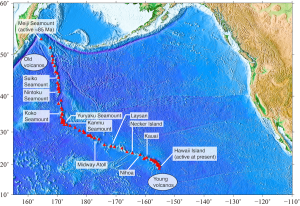1.4 Creation of the Japanese Archipelago by a change in the directions of tectonic plate movements
*The contents may be subject to change without prior notice.
K. Z. Nanjo and K. Oike
NaDiR, Global Center for Asian and Regional Research, University of Shizuoka
This section examines how the Japanese Archipelago was formed. In the process, the Pacific plate on which Hawaii sits played an important role. Beneath Hawaii, magma is constantly moving upward from a great depth. The Pacific plate is moving westward at the rate of a few centimeters per year, creating a chain of seamounts that stretches to the west from Hawaii (Fig. 1-11). A closer analysis reveals that the Pacific plate was moving from south to north in ancient times, but then changed direction about 43 million years ago. Hawaii ~85 million years ago (1) was located near the Kamchatka Peninsula of Russia. For unknown reasons, the seamounts were named after Japanese historic emperors by an American researcher.

Fig. 1-11: The chain of Hawaiian islands and seamounts. Locations of triangles are based on Kamata (2009) (2). Age of the Meiji Seamount ~85Ma was obtained from Regelous et al. (2003) (1), where Ma indicates million years ago.
After changing direction, the Pacific plate was subducted beneath Japan, while a landmass at the far-eastern edge of the Eurasian Continent broke off and a lake was formed, which triggered the formation of the Japanese Archipelago. The lake continued to expand and became the present-day Sea of Japan about 16 million years ago. As such, the Sea of Japan is one of the youngest seas in the world. On the opposite side facing the Pacific Ocean, the Pacific plate which was more than 100 million years old was subducted beneath Japan after traveling great distances, forming the oldest seabed in the world. The co-existence of these young and old seas is one of the characteristics of Japan.
Located at mid-latitudes, Japan has four distinct seasons. Also, Japan is a unique mid-latitude country for its heavy snows, which are due to the Sea of Japan sandwiched between the Eurasian Continent and Japan. The Tsushima Current, a warm current, flows into the Sea of Japan. During the winter monsoon season, a dry, cold air mass comes from the continent and picks up large amounts of water vapor as it passes over the Sea of Japan, generating clouds. When these clouds reach Japan and collide with its high mountains, they are forced upward and release their water in the form of heavy snow. Japan holds the Guinness World Record for record-high snowfall of 11 meters observed at Mt. Ibuki in Shiga Prefecture.
The Izu Peninsula (3) is the only part of Honshu, the Japanese main land, that sits on the Philippine Sea plate. The peninsula was originally a volcanic zone, which drifted from far south and became the peninsula we know today about 600,000 years ago. The zone began colliding with Honshu about a million years ago and became part of the land in the last phase of the formation of Honshu. The Izu Peninsula is located in a volcanic zone. Here, the underground magma was so light that it did not subduct; it collided with Honshu instead.
When a subducted oceanic plate reaches about 100 kilometers underground, upwelling flows are generated within the mantle, and the rock inside the mantle melts and turns into magma. Because the upwelling flows at an earlier stage are flows of magma that are lighter than the surrounding rock, the magma ascend to a depth of 5 to 10 kilometers from the surface where an equilibrium is maintained. This spot is called a “magma chamber.” Active volcanos form directly above magma chambers, and beneath them, a subducted oceanic plate at a depth of around 100 kilometers lies. A chain of active volcanos such as this is called a “volcanic front” (4) (Fig. 1-3). In some parts of western Japan, there is no volcanic front, which may be because of the lack of an oceanic plate that has subducted to such a depth.
Sources and references
- M. REGELOUS, A. W. HOFMANN, W. ABOUCHAMI, S. J. G. GALER, Geochemistry of Lavas from the Emperor Seamounts, and the Geochemical Evolution of Hawaiian Magmatism from 85 to 42 Ma, Journal of Petrology, 44(1), 113–140, 2003, https://doi.org/10.1093/petrology/44.1.113
- Kamata, H., 「地学のツボー地球と宇宙の不思議をさぐる」(Chikumashobo Ltd., Tokyo), 2009 (in Japanese)
- Izu Peninsula Geopark
- Volcano in Japan (Geological Survey of Japan)